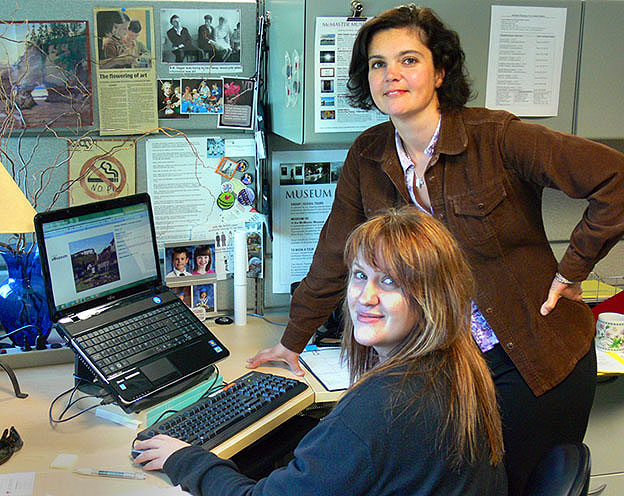No beret required: Mac art collection going digital

Julie Bronson, right, collections administrator at the McMaster Museum of Art, helps student Dominika Jakubiec, left, search the Museum's collection online. Two new projects at the Museum offer an in-depth look at its extensive holdings.
How many Picassos does McMaster have? When did the University get a Monet? What connects First Nations art to pop art? Thanks to a new online resource network, these and many other questions can be answered in the blink of an eye.
The McMaster Museum of Art (MMA) has launched two digital projects that provide unprecedented, in-depth access to the University’s art collection. The projects include an online database, eMuseum, and its complement, the Curiosity Engine — a virtual gallery for exploring connections between genres and artworks. Both intiatives have been generously funded by Dr. John Panabaker and a Museums & Technology Grant from the Ministry of Culture and Tourism.
The eMuseum provides an up-to-date searchable database of McMaster’s art collection, complete with thousands of entries, origin stories, details about each object and where copyright allows, an image.
In launching this project, McMaster becomes part of a network of major art institutions — including the Smithsonian in Washington, DC, the Frick Collection and the McMichael Canadian Art Collection. The MMA collection has joined their collective database, and is accessible by curators and researchers at those galleries.
“This project will be an invaluable resource for McMaster students, visitors and researchers around the globe,” says Museum Director Carol Podedworny. “It has been 20 years since the last comprehensive collection catalogue was published, and the Museum has acquired thousands of objects in the interim. The digitization project was a massive undertaking, requiring many hours of staff research, data entry and photography by the late John Tamblyn.”
“McMaster has an outstanding collection of important works of art and now the world will know it.”
The second component, the Curiosity Engine (developed by the media visionaries at Parallel World Labs), is a tool for visitors to explore the connections between artists and artworks through related content and the lenses of culture, history and society. The objective is to offer both an understanding and an emotional relationship to works of art, and offer an understanding of how artists observe our changing world through creative processes.
The beta version begins with a contemporary work by First Nations artist Bob Boyer, and goes on to explore the stories of the Americas and beyond. The Engine is designed to expand and encompass more of the collection and build connections over time.
“Support for these projects has really catapulted the Museum into the 21st Century, allowing us to go digital in a big way,” says Podedworny.
Still have questions? The answers are only a keystroke away at the MMA website.

